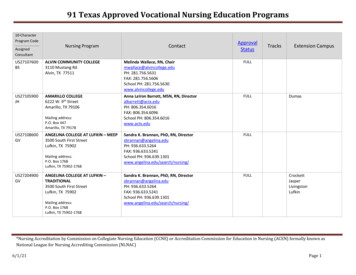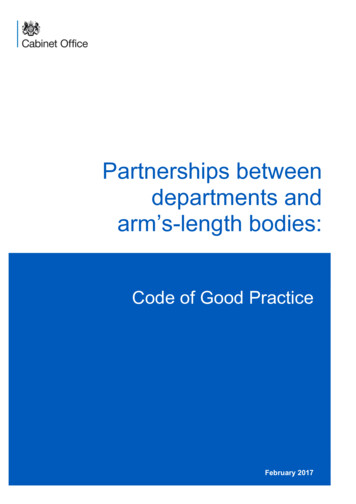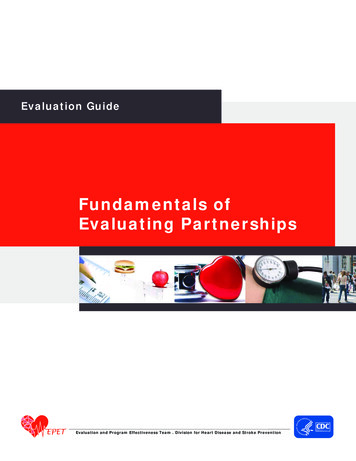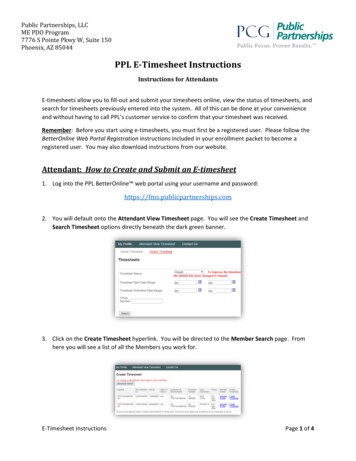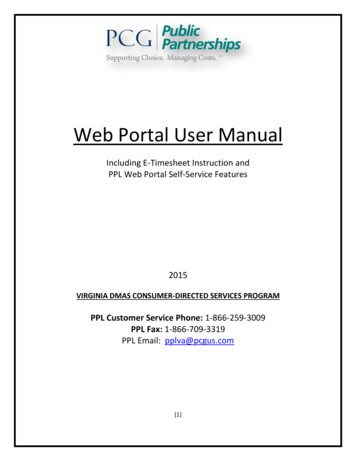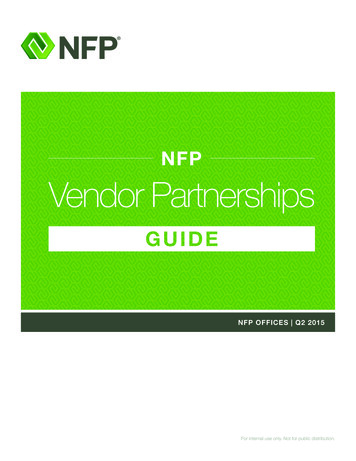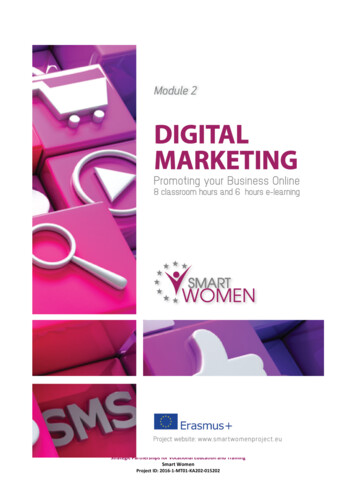
Transcription
Strategic Partnerships for Vocational Education and TrainingSmart WomenProject ID: 2016-1-MT01-KA202-015202
Strategic Partnerships for Vocational Education and TrainingSmart WomenProject ID: 2016-1-MT01-KA202-015202In the framework of the Smart Women project, seven partners from European countries havecreated an innovative European Training Model, focused on women, aiming for encouragingentrepreneurship and putting business ideas into practice.The Smart Women Model combines online learning using online learning platforms and faceto face training based on project collaboration, peer-learning, guidance, coaching andcounselling.Project Partners: MCA (Malta), LIKTA (Latvia), Dedalo Fundacion (Spain), EOS (Romania),Cyprus Computer Society (Cyprus) and ALL DIGITAL (Belgium).DISCLAIMERThe European Commission support for the production of this handbook does not constitute anendorsement of the contents which reflects the views only of the authors, and the Commissioncannot be held responsible for any use which may be made of the information contained therein.Page ii 2017
DIGITAL MARKETINGWith the rapid rise of consumers using the Internet for work, communication, shopping andrecreation, virtually every organisation should have an online presence and be effectivelyleveraging digital marketing opportunities. This means keeping up-to-date with online toolsand knowing how to use them to achieve overall business and marketing goals. This coursewill guide you through the key skills you need to achieve your digital marketing goals.The course sets out essential concepts and skills relating to the fundamentals of digitalmarketing, including creating a web presence, optimising content for search engines, usingsocial media platforms, carrying out online marketing across a range of services, as well asmonitoring and improving campaigns using analytics.LEARNING OBJECTIVES 2017Having completed this module you will be able to:Understand key concepts of digital marketing, including advantages, limitationsand planning.Understand various web presence options and how to select appropriatekeywords for search engine optimisation.Recognise different social media platforms, and set up and use commonplatforms.Understand how effective social media management assists in promotion andlead generation.Use a social media management service to schedule posts and set upnotifications.Understand various options for online marketing and advertising, including searchengine, e-mail and mobile marketing.Understand and use analytics services to monitor and improve campaigns.Page iii
ANNOTATIONSThe following icons are used in the text with the meaning indicated.IconUsed asConcepts & TheoryResources & links the student can use for further readingReview ExerciseTasks to be performed by student individuallyTasks to be performed by students in groupsPage iv 2017
MODULE OUTLINEThe course is implemented using a blended-learningapproach and includes 8 hours of classroom and 6 hours of elearning Digital marketing conceptsØ Introduction to Digital marketing concept and elementsØ Typical digital marketing goals ( increased brand awareness, salesgeneration, customer information; improved customer service etc)Ø The advantages and limitations of digital marketingØ Introduction to main legal and regulatory obligations with digitalmarketing Digital marketing channels and toolsWeb presenceØ Web presence solutions ( information website, online businessdirectory, social media, mobile site, mobile application)Ø Main elements and best practices of websiteØ Search engine optimization. KeywordsDigital social media platforms for marketingØ Common social media marketing campaign elements and platformselection for particular audience;Ø Creation and editing of social media business profile informationØ Creation, editing and scheduling social media postsØ Good practices and tips in developing social media marketingcampaignsØ Evaluation of social media marketing campaigns 2017 Other Online marketing toolsØ E-mail marketingØ Online advertisingØ Mobile marketing Online marketing analytics and evaluationØ The importance of analytics and evaluationØ Google analytics as the common website analytic toolØ Social marketing analyticsPage v
DIGITAL MARKETINGDigital Marketing .iiiLearning Objectives .iiiAnnotations . ivModule Outline . vDigital Marketing . viLESSON 1 - KEY CONCEPTS . 11.1 Digital Marketing Overview . 21.2 Digital Marketing Techniques . 31.3 Digital Marketing Goals . 41.4 Digital Marketing Advantages . 41.5 Digital Marketing Limitations . 61.6 Legal and Regulatory Obligations. 61.7 Additional Resources . 81.8 Review Exercise . 91.9 Tasks . 10LESSON 2 - DIGITAL MARKETING CHANNELS & TOOLS . 12.1 DM Channels & Tools . 22.2 Search Engine Marketing Platforms . 32.3 Online Advertising Platforms . 72.4 Types of Online Advertisement. 82.5 Social Media Advertising . 92.6 Content Marketing . 122.7 Additional Resources . 142.8 Review Exercise . 152.9 Tasks . 16LESSON 3 WEB PRESENCE. 173.1 Web page and website . 183.2 Website Platforms . 183.3 A Domain Name and Host . 213.4 Creating Website (important rules) . 213.5 Web banner . 233.6 Web directories . 243.7 Keywords and search engine optimization . 263.8 Additional Resources . 30Page vi 2017
3.9 Tasks . 31LESSON 4 SOCIAL MEDIA PLATFORMS FOR MARKETING . 324.1 Social Media . 334.2 Social Media Platforms (LinkedIn, twitter, Instagram, YouTube) . 334.3 Facebook – www.facebook.com . 394.4 Additional Resources . 424.5 Tasks . 43LESSON 5 OTHER DIGITAL MARKETING TOOLS. 445.1E-mail Marketing . 455.2Mobile marketing tools and platforms . 495.3 Additional Resources . 555.4 Tasks . 56LESSON 6 DM CAMPAIGN EVALUATION & ANALYTICS . 576.1 Static Timing Analysis & Google Analytics . 586.2 Facebook Analytics . 616.3 Additional Resources . 656.4 Tasks . 66Module Completion . 67 2017Page vii
LESSON 1 KEY CONCEPTSAfter completing this lesson, you should be able to: Understand the term digital marketing Define the main elements of digital marketing Identify typical goals when using digital marketing Understand the advantages of digital marketing Understand the limitations of digital marketing Recognise the main legal and regulatory obligations when digitalmarketing in your country
Lesson 1 – Key ConceptsDigital Marketing1.1 DIGITAL MARKETING OVERVIEWConceptsDigital Marketing, sometimes called Internet or online marketing, can be describedas the set of techniques and technologies used to promote brands, products andservices to consumers over a range of online channels.Digital marketing overviewPeople are spending more and more time online carrying out a range of tasks,including shopping, searching for information, reading news, watching videos,using e-mail, booking holidays, and using social media. They are also using awider range of devices such as laptops, tablets, and smartphones, allowing themto be online anytime, anywhere. What this means is that people are spending lesstime using traditional media, such as print and television. Businesses thereforeneed to get online in order to reach both their existing and potential customers.They need to engage in digital marketing in order to promote and sell theirproducts and services over various online channels.Page 2Key Concepts 2017
Digital MarketingKey Concepts1.2 DIGITAL MARKETING TECHNIQUESConceptsDigital marketing techniquesThere are many digital marketing techniques and tools available to businesses tohelp them market online, such as: Affiliate marketing – Rewarding a site or individual for each sale/lead itgenerates as a result of promoting your business. Display advertising – Advertising online in a variety of formats. Displayadvertising includes banner, text, image, and video ads on a webpage. Content marketing – Creating and sharing useful, relevant and qualitycontent to achieve marketing goals. Search engine marketing (SEM) – Increasing website traffic and visibilityin search engine results pages through paid and unpaid (organic)methods. Mobile marketing – Reaching consumers through their mobile phone,smartphones and tablets. E-mail marketing – Reaching consumers directly via e-mail using textand rich media formats. Social media marketing – Reaching consumers through social mediasites, such as Facebook, Twitter, and LinkedIn, to raise brand awareness,generate sales and website traffic. Search engine optimisation (SEO) – Optimising websites to increasetheir visibility in search engine's unpaid results, also known as organic,natural or earned results. Analytics – The process of using tools for tracking and analysing thebehaviour of website visitors to inform marketing strategy. 2017Key ConceptsPage 3
Lesson 1 – Key ConceptsDigital Marketing1.3 DIGITAL MARKETING GOALSConceptsAs with any marketing activity, it is important to start by establishing the goals youwant to achieve with digital marketing.What are your goals?Some typical goals might include: Increased brand awareness – Increasing brand awareness amongcurrent and potential customers. Lead generation – Generating ‘leads’: generating customer interest inyour product or service and creating contact lists of those users who haveexpressed interest. Sales generation – Generating sales of your products or services –probably the ultimate marketing goal. Informing customers – Keeping customers up-to-date by sharing newsand special offers with your target audience. Improved customer service – Strengthening your relationship with yourcustomers by improving customer service and assistance. Direct customer engagement – Engaging with customers directly. Generating Traffic – Increasing the number of visitors to your website.1.4 DIGITAL MARKETING ADVANTAGESConceptsDigital marketing has many advantages over traditional marketing .MobileDigital marketing advantagesMore cost effectiveDigital marketing is generally less expensive than traditional marketing channelssuch as television, radio and print. The design and production costs for a print orTV ad, plus the cost of buying advertising space in a magazine or on a televisionchannel, are usually much higher than an online banner ad or video ad.Page 4Key Concepts 2017
Digital MarketingKey ConceptsEasier to track and measure progressIt is much easier to track and measure the effectiveness of a digital marketingcampaign than on traditional media. In non-digital campaigns, the majority ofaudience data is estimated, such as magazine or newspaper circulation figures, oraudience numbers for a television or radio programme. These numbers may notaccurately reflect the actual number of people who saw or engaged with youradvertisement. However, the use of online analytics tools in a digital campaign willgive exact, reliable data for how many people saw and engaged with (clicked)your ad.Also, in traditional campaigns, campaign performance data is rarely real-time. Forexample, you might have to wait and see if sales figures increase over a period oftime. However, in a digital campaign, online analytical tools offer real-time trackingand behavioural data revealing your audience’s reaction to your ad, allowing youto tweak your campaign and improve performance.Larger demographic reachDigital marketing campaigns also have a larger potential reach than traditionalcampaigns. They can reach a global audience but they can also be targeted soyour message only reaches a specific group, also known as a demographic.Demographics include things like gender, race, age, income, location, education,marital status. Targeting your message to a particular demographic you are morelikely to reach people who are interested in your category of product or service.Higher engagement compared to traditional marketingDigital marketing allows customers to engage with brands more directly than withtraditional marketing such as print and television. On social media for example,customers can like, share and comment on a business’s content, and in turnbusinesses can interact with customers by answering questions or responding tocomments. Even though the engagement isn’t face-to-face, online interaction canhappen in real time, at any time, and directly between businesses and customers.Catering to mobile customersAnother advantage of digital marketing is the ability to reach mobile users withcampaigns tailored to their situation. This can include tailoring the type of contentthat mobile users see depending on where they are and the device they’re using.It also means ensuring that the content can be viewed easily on a mobile device.Digital marketing advantages 2017Key ConceptsPage 5
Lesson 1 – Key ConceptsDigital Marketing1.5 DIGITAL MARKETING LIMITATIONSConceptsThere are also some limitations to digital marketing to be aware of.1.Lack of face-toface interaction2.Can beobtrusive3.Timecommitment4.May not besuitable foryour productDigital marketing limitationsLack of face-to-face interactionWith digital marketing, contact with customers is online, so there is a lack ofreal-life interaction. This means that your campaigns may not reach customerswho prefer real-life, face-to-face contact with businesses. It may also meanthat useful feedback and insights from people who purchase (and don’tpurchase) is lost.Can be obtrusiveSome users consider some formats of online advertising as annoying or aninterruption to their online experience. Pop-up ads are the best example ofonline ads that people dislike. Some people come to view online advertising asclutter, and aim to ignore it. It is important to conduct your campaigns anddesign your content in a way that doesn’t upset your audience or lead them toview it as obtrusive. Testing your campaigns with small groups first is a goodway to ensure this is the case.Time commitment to manage it professionallyAnother consideration is that planning and managing a digital marketingcampaign professionally will require a considerable amount of time andresources. A business profile account on a social media site might be free, buttime and resources are needed to manage it well. A badly-managed orabandoned campaign or social profile can have negative consequences foryour business. This is why the planning stage is so important.May not be suitable for your productThere will be some customers you can’t reach through online channels. Forexample, some customers in an older age bracket may not be online, or insome countries online access may not be prevalent. It is important to knowabout your target audience’s lifestyle and habits, and whether you will be ableto reach them online.1.6 LEGAL AND REGULATORY OBLIGATIONSConceptsPage 6Key Concepts 2017
Digital MarketingKey ConceptsOnline activity is governed by laws and regulations to protect internet users, suchas online buyers or those who have created content (copyright owners).It is important to follow any applicable laws and regulations related to yourmarketing activity. These may differ depending on the country and may alsochange to respond to technology. You should check the latest laws andregulations, which can typically be found on government or regulatory authoritywebsites or by consulting with a legal professional.Many countries have restrictions around advertising of alcohol for example. Inmany countries, alcohol can only be advertised to someone over 18 years old.However in Sweden the age is 25, in the United States it is 21, and in Canada andSouth Korea it is 19. In some countries alcohol may be prohibited, so advertisingsuch a product in these markets could lead to heavy penalties.Some considerations include the regulations and laws around data protection andprivacy, copyright and e-commerce. For example, privacy laws may require a userto consent to a website gathering and analysing their data through the use ofcookies. Using photographs and video on social media that were created bysomeone else may be infringing copyright. If you have an e-commerce website,you should also be familiar with the terms and conditions of your paymentprovider.Some advertising platforms have their own regulations that you should be awareof. For example, Facebook prohibits the advertising of any tobacco-relatedproducts, weapons, and pharmaceutical drugs on their platform. They also havestrict guidelines on imagery, and won’t allow images that they feel depict anegative body image, such as a body portrayed as overweight or perfect. 2017Key ConceptsPage 7
Lesson 1 – Key ConceptsDigital Marketing1.7 ADDITIONAL RESOURCESYou may explore the following learning resources to enrich and upgrade yourknowledge and skills.On Basics of DMTop 10 Benefits of Digital Marketing for Small BusinessesBeginners Guide to DMDigital Marketing BasicsOn Legal IssuesWhat does EU Data Protection Regulation Mean for DigitalMarketing?General Data Protection ExplainedGDPR Explained (Video 1)GDPR Explained (Video 2)On DM Channels & ToolsDigital Marketing Channels & ToolsKey Elements of Digital Marketing (Video)Digital Marketing Case StudiesPage 8Key Concepts 2017
Digital MarketingKey Concepts1.8 REVIEW EXERCISETo ensure that you have mastered the concepts presented in this lesson, youmay attempt the following review exercise. Read the instructions carefullybefore you answer.1. Questions may vary in type and can include:multiple choice with three or more options,listing responses or filling blanks of one or more words or completing sentences or anyother innovative question you may come up with.2. Digital Marketing can be described as the set of andused for promotion of brands, products and services over a rangeof .channels.3. List three business goals you might want to achieve using digital marketing:4. List three advantages of using digital marketing over traditional marketing techniques. 2017Key ConceptsPage 9
Lesson 1 – Key ConceptsDigital Marketing1.9 TASKSNow is time to do some practical work and apply the knowledge you gainedduring the lesson. Read the instructions carefully before you attempt the tasks.Task 1.Describe the task to be performed by the students here.Task 2.Describe the task to be performed by the students here.Task 3.Describe the task to be performed by the students here.Page 10Key Concepts 2017
LESSON 2 DIGITAL MARKETING CHANNELS & TOOLSAfter completing this lesson, you should be able to: Identify some common examples of online advertising platforms Understand different types of online advertisement Understand the term sponsored post Recognise the importance of sponsored posts in increasing interaction andengagement on social media Identify some common examples of search engine marketing (SEM)platforms
Lesson 2 – DM Channels & ToolsDigital Marketing2.1 DM CHANNELS & TOOLSConceptsYou can advertise through different online channels such as search engines(search engine marketing), websites and blogs (display advertising), and socialmedia (sponsored posts and promoted al MediaAdvertisingDisplayAdvertisingOnline advertising channelsPage 2DM Channels & Tools 2017
Digital MarketingDM Channels & Tools2.2 SEARCH ENGINE MARKETING PLATFORMSConceptsSearch engine marketing (SEM) includes ads that appear in search engine resultspages. This is known as pay-per-click advertising (PPC), as you only pay whensomeone clicks your ad. Search engine advertising enables you to reachcustomers at the exact time that they are searching for your product or service. Italso allows you to target customers effectively by specifying exact search termsand location – for example if you are a local business you can reach onlycustomers in your area.SEM platforms allow you to create advertising campaigns to target your audiencewhen they are searching online. The two most common SEM platforms for searchengine advertising are: Google AdWords (https://www.google.com/adwords/) Bing ads (https://bingads.microsoft.com/)How does Search Engine Marketing work?Getting started with search engine advertising involves a series of steps:1. Create anSEM platformaccount2. Create anad campaign3. A usersearches5. Your ad isclicked4. Your ad isdisplayedStep 1: Create an SEM platform account. For example, set up a GoogleAdWords account.Step 2: Create an ad campaign. You complete relevant details in a standardtemplate. For example, create a SEM campaign in Google AdWords: 2017DM Channels & ToolsPage 3
Lesson 2 – DM Channels & ToolsDigital Marketinga. Set your budget – this is based on how much you want to spend. Forexample, in Google AdWords you can set how much you want to spend perday.b. Select your target audience location – you can target customers bylocation, either globally or locally.c. Select the type of advertising network – for example in Google AdWordsselect Search Network, which is made up of Google search sites and sitesusing the Google search engine. Note: For SEM, don’t select DisplayNetwork (sites that allow you to display ads to people while browsing).d. Select keywords – these are the words that you think people will searchfor when looking for your product or service. Include negative keywordsthat will prevent your ad from showing to eliminate unwanted clicks.Google’s Keyword Planner, available if you use Google AdWords, offerskeyword information for search ads:adwords.google.com/ko/KeywordPlanner.e. Decide on your bid – This is the maximum amount you want to pay for aclick on your ad. The SEM platform calculates this based on your budgetand the keywords you have selected or you can set it manually.f. Write your ad text – This is text-based and typically includes a URL wherethe user goes after clicking your ad, known as the landing page; Headlinetext which is the title for your ad or webpage and contains keywords or acall to action; and a short description of what you are offering.Page 4DM Channels & Tools 2017
Digital MarketingDM Channels & ToolsStep 3: A user searches for a word or phrase in a search engine.Step 4: Your ad is displayed. If the search term matches the keywords you haveidentified in your ad, your ad is shown in the search results page. Typically adsappear at the top or to the right of the organic results in the search engine resultspage and are identified as ads. The position of your ad will be determined by yourbudget relative to other advertisers and the quality of your ad. For example, if youidentify the keyword “ECDL” and someone searches for ECDL, where your adappears will depend on whether you have bid higher for that keyword than otheradvertisers who also bid on it.a.b.a.Google SERP 2017DM Channels & ToolsPage 5
Lesson 2 – DM Channels & ToolsDigital Marketinga.b.a.Bing SERPa. Advertisers are charged if a user clicks an ad in the results.b. Organic results typically appear beside or below the ads.Step 5: Your ad is clicked. If your ad appeals to the person searching they mightclick your ad. You only pay when your ad is clicked. Depending on how your ad isset up the person clicking your ad might visit your website, get directions to yourpremises or call you.Page 6DM Channels & Tools 2017
Digital MarketingDM Channels & Tools2.3 ONLINE ADVERTISING PLATFORMSConceptsThere are many online advertising platforms but the biggest is the Google DisplayNetwork (https://www.google.com/ads/displaynetwork/).The Google Display Network includes sites, blogs, videos or apps that belong toGoogle or are in the Google network. This includes sites that sell advertisingspace using Google AdSense, another Google product.Other examples include the Yahoo! Bing Network and YouTube ads (part of theGoogle Display network).How does display advertising work?Online advertising platforms support display advertising,which shows ads to online visitors. In display advertising you1. Create anOnlinepay for ads to appear where your target audience are likely toAdvertisingbe, for example looking at sites, blogs or mobile apps thataccountinterest them. For example, if you are selling weddingbouquets your ad might appear when someone is browsing ablog about weddings. Display advertising enables you togrow awareness of your product or service, but it can beexpensive.2. Create an adGetting started with display advertising involves a series ofcampaignsteps:Step 1: Create an online advertising account – Forexample to use the Google Display Network, you must set-upa Google AdWords account.Step 2: Create an ad campaign – For example in GoogleAdWords create a new campaign and complete the relevant3. Create your addetails. Select the advertising network, for example selectDisplay Network only to advertise on the Google displaynetwork only. Select if you want your ads placed on relevantsites automatically or if you want to specify sites. Select yourmaximum daily budget and your bidding preferences - payby the number of clicks (the number of times your ad is4. Your ad isdisplayedclicked), impressions (the number of times your ad is seen)or conversions (the number of actions, as specified by youthat are completed). Select the audience for your ads basedon factors such as age, interests, preferences and locations.Step 3: Create your ad – For example in Google AdWordsyou can create text, image, display or mobile ads.5. PaymentStep 4: Your ad is displayed – If a user browses a pagethat is relevant to you
marketing, including creating a web presence, optimising content for search engines, using social media platforms, carrying out online marketing across a range of services, as well as monitoring and improving campaigns using analytics. LEARNING OBJ
